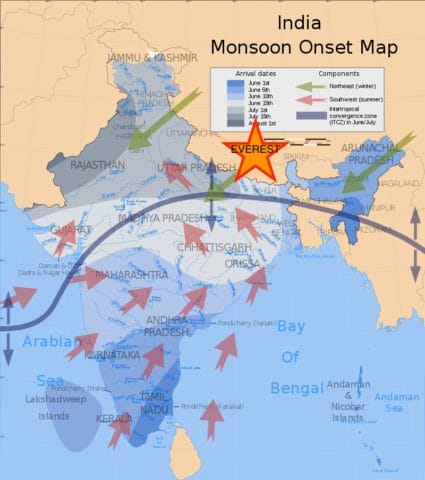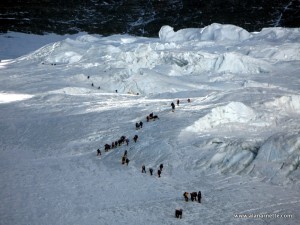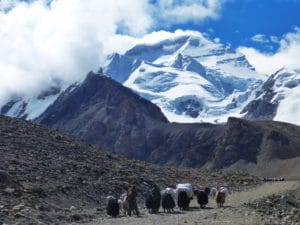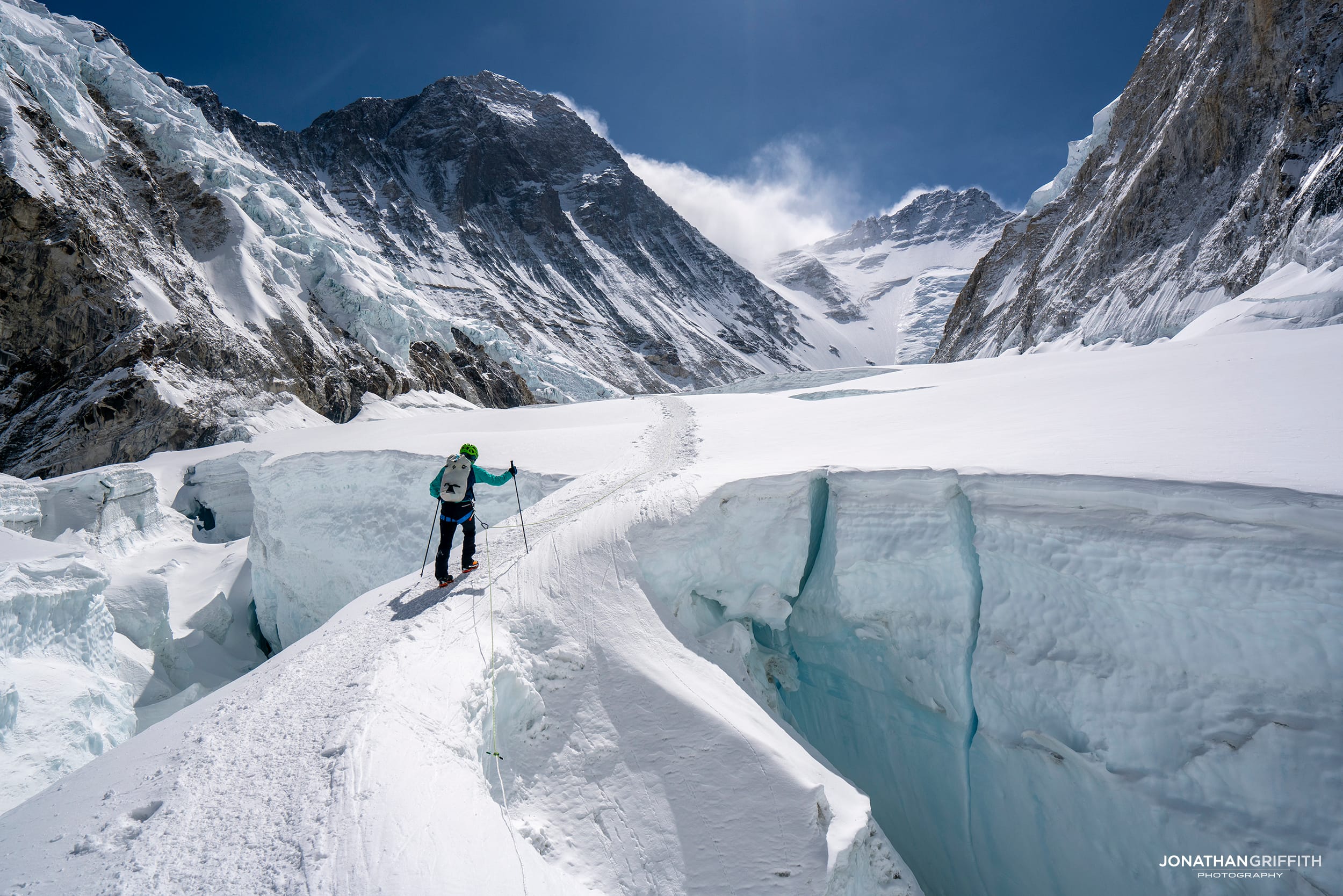It’s early May on Everest so that must mean the wind is blowing, and how it blows! Most teams are back in their base camps waiting out what is forecasted to be several days of 100mph/160kph winds above 8000 meters on both sides. This means no rope fixing, no reaching 8000 meters for acclimatization for those climbing without supplemental oxygen and it also means a test of mental toughness for many on the Hill. All this said, there were summits on Cho Oyu today and talk of Everest summit on 13 May. Climbing in the Himalaya is in full bloom!
The Big Picture
I’ve been on or writing about Everest since 2002 – 16 years now and each season plays out very similarly. Teams do a great job of getting their acclimatization rotations in during mid to late April causing everyone to talk about early summits. Then the weather changes with snow and high winds causing everyone to talk of late summits. In the end, it all works out but occasionally goes the wrong way. In 2012, everything was going well until the early May weather hit, and it stayed until late in the month. When there was finally a forecast of a few days to summit, everyone went at the same time and the crowds were difficult. That event caused many changes to take place starting with better communication amongst the team leaders, better cooperation between teams with respect to rope fixing and dual ropes in the places where bottlenecks occurred. This year, dual ropes are already on the Lhotse Face, above C3 and the top of the Geneva Spur. It remains to be seen what condition the Hillary Step is in, or if in fact it has become the Hillary Slope. In any case, it is a rise of 30 meters, 100 feet and often slows everyone going up and down. The rope team will most likely put in dual ropes, if they can this year.
Before there is too much talk about crowds and late summits, let’s keep all this in perspective. This is how I summarized the 2005 season when weather proved difficult:
Quite a season! The summits on May 21 were the latest first summit day in 45 years of climbing Mt. Everest. Norgay and Hillary did it on May 29, the earliest was April 4 in 1984. But it was still a good year for summits with over 230 climbers standing on the top of the world. To put this in context, around 150 made the summit in 2004 with the first summits on May 15.
And in 2012, the first summits were also a bit late:
A team of Sherpas set out the evening of May 17 to set the route to the summit. This team of skilled Sherpas came from IMG, AAI, Peak Freaks, Chilean, 7 Summits. On their heels was a Chilean team, 20 strong, lead by Chilean legend Rodrigo Jordan. They along with the rope fixers plus Ueli Steck who tagged along, umm, without supplemental O’s I might add, all summited the morning of May 18 – the first of the season.
So this year while sitting at 7 May, people might start getting antsy, history has shown there is still a lot of time left. On the Nepal side the driving factor for when the season “ends” is when the Icefall Doctors declare the Icefall too dangerous to maintain. Traditionally this has coincided with the arrival of the monsoons, about 1 June. On the north side, there is no hard stop given the absence of an Icefall type feature.
Weather Outlook – Improving from Bad to Ideal?
Back to 2018, there is a common theme to all the weather repots coming in. Winds are screaming above 8000 meters but are calm lower on the mountains. Both Adrian Ballinger on Cho Oyu, Ryan Kushner on Dhaulagiri and Ben Jones on Everest all confirm this. Ben posted: “The winds are roaring on the upper mountain, but from some reports from Sherpa coming back from the South Col there were not much winds there, and we also hardly had any winds on our climb to Camp 3 today.”
I went back to my weather experts, Chris Tomer of Tomer Weather Solutions and Michael Fagin of Everest Weather to see what they think about think will happen. Chris feels that after this wind event, the jet stream will retreat from the Himalaya around May 11 thus the summit door swings wide open for optimal summit conditions from Dhaulagiri to Everest. He went on to say the jet stream might largely stay away for 1-2 weeks but that a few snow days will be inevitable with jet stream winds that light. Bottom line from Chris for his members was that: “the long-term jet is favorable and they can do this.”
 Michael talked a bit more about the impact of the monsoons and why the season ends around June 1. He said that while many teams are currently looking at some strong summit winds for parts of this week, there other weather patterns that need to be monitored. “I think it is important to monitor to see if there are any tropical depressions in the Bay of Bengal. There are times (not right now!) in May that these form into strong typhoons and bring devastating heavy rains and winds to Bangladesh. Interesting enough sometimes if the upper level wind patterns are right these storms tract toward the Everest region. If they do this can bring copious amounts of snow to the area. The best source for tracking these storms is from the US Navy Joint Typhoon Warning Center.”
Michael talked a bit more about the impact of the monsoons and why the season ends around June 1. He said that while many teams are currently looking at some strong summit winds for parts of this week, there other weather patterns that need to be monitored. “I think it is important to monitor to see if there are any tropical depressions in the Bay of Bengal. There are times (not right now!) in May that these form into strong typhoons and bring devastating heavy rains and winds to Bangladesh. Interesting enough sometimes if the upper level wind patterns are right these storms tract toward the Everest region. If they do this can bring copious amounts of snow to the area. The best source for tracking these storms is from the US Navy Joint Typhoon Warning Center.”
He goes on to discuss the end of the season and weather. “The main reason is the onset of the Monsoon, see map to the right. Close to June 1 there is a strong southerly flow that brings moist air from the Bay of Bengal into India and Nepal and of course into the entire Himalaya region including Mt. Everest. The net result is starting in June and continuing through the summer India and Nepal get periods of heavy precipitation which certainly causes issues for mountaineering in that region. Thus climbers focus on Everest in May and then in the fall as the monsoon retreats climbers return. Thus in the fall many mountains in the Himalaya are climbed however normally not Everest.”
Nepal Update
The ropes are into Camp 4 or the South Col and Sherpas are stocking the High Camp with oxygen and tents for the summit push. Most teams are back at Everest Base Camp right now or even lower. The Icefall is reported to be melting a bit early but no huge cause for concern – yet. Overall the season is going pretty well and on schedule. Remember that the last two years, the ropes made it to the summit around 11 May, so it is way too early to create a cloud of worry.
However, Mingma G Sherpa shows both his impatience and confidence with a declaration that, “Finally our Everest Summit day is out. 13 May 2018 must be our day” He is quite vocal about his displeasure that the ropes have not been fixed to the summit of Everest so I would not be surprised to him take his small team of Chinese climbers and push before the official rope team has a chance to do their job. This same group summited Lhotse last week with no ropes up the last gulley to the summit. Mingma has double amputee, Mr Xia Boyu on his team. This could be interesting.
Tibet Update
Teams have slept at the North Col and even hiked a bit higher up the Northeast Ridge. The ropes are around 8300 meters and have a ways to go to the summit. It has been windy on that side, but that is the norm for the North side of most large peaks. Last year was unusual with the North calmer than a very windy South.
Dominick Renshaw with Summit Climb commented on his rotation and the winds:
Back safe at Basecamp, what an awesome second rotation. We camped on the North Col at 7035m, we would have gone higher but the winds were brutal, when I say the were gail force I’m not joking and we were simply in a little tent. The view was amazing but the temp was so cold, I didn’t get much footage this time, but know to take the video on arrival next time.a little knackered so will try to get a full update out tomorrow. Life is good. Dom
“Touch Grass”
It has become almost universal on the south side to descend down valley for a few nights of R&R before the summit bid. Anatoli Bourkreev coined the phrase “touch grass before the summit” Jagged Globe noted that three of their members flew down to touch grass:
A period of very strong summit winds is forecast for 8-12 May and this could stop all work on the upper mountain for a few days. Our earliest possible summit window now looks to be around 16 May, assuming suitable weather. Therefore the climbers will be confined to Base Camp for up to a week. Hence the decision of three of the team to fly down to Namche for a few days where the air is thicker and there is some good apple pie available. They intend to return to BC on 9 or 10 May.
Who Summits First?
There are over 30 teams on Everest ranging from two people to 100. Almost without exception all depend on Sherpas to establish camps, including ferrying food, fuel, tents, and supplemental oxygen. While you may read about someone climbing solo, alone or “self supported” in reality they are supported by the Sherpas and Tibetans who set ropes and ladders on both sides. If they clip into someone else’s rope or step on a ladder, they are supported. And some “independent” climbers depend on Sherpas to establish their camps just like the commercial teams. This is not meant to criticize, but to clarify and to frame the problem. (well maybe a slight criticism of their transparency and acknowledgment of the support they use)
There are 3 things that need to happen before anyone summits:
#1 Fix Route

This is the deal; the tradition is that the Sherpa and Tibetan rope fixing teams to summit Everest first. While it is possible for someone to climb independent or without fixed ropes, it is rare but we may see it this year with Mingma G..
#2 Acclimatize
The average Everest expedition arrives at base camp in early April in order to acclimatize by climbing to between 20,000 and 23,000 feet. At this point in the season most all members have completed their rotation but there is a surprising number of people who only have one competed. They might be in the last summit waves.
#3 Good Weather

As already discussed extensively, a weather forecast is the primary factor that drives the crowds. If there are only a few good weather days, everyone elbows to get their spot in line. The normal range is 6 to 16 days with an average of 11 since 2001. In 2012, the year most talked about for crowds, it went down to four.
So who goes first? It usually the teams that are health and rested but sometimes it’s the ambitious ones who are willing to push. Remember, sometimes it’s not good to be first. Again, 8000 meter climbs are a marathon and at mile 23, when you hit the wall, you may have wished for a couple more rest days.
The Other 8000ers
Let’s do a quick summary of the other 8000 meter peaks being climbed this spring season.
Lhotse – Summits
Last week saw six climbers summit Lhotse There are 88 climbers for Lhotse this season. The ropes are fixed within 100 meters of the top. Look for more Lhotse summits immediately upon calmer winds.

Cho Oyu – Summit in Big Wind!
A small team from Alpenglow pushed the envelope and went for the summit in what they reported to be -45C windchills and made it! Adrian Ballinger wrote me to say that 3 members with 2 guides with 5 Sherpas all made the true summit in high winds but lower on the mountain it was calm. They used supplemental oxygen at 4 lpm. The four westerners arrived in China only 8 days ago after “pre-acclimatizing” at home. He said that all 10 were exceptionally strong climbers:
Climbing today was, as you said, a calculated risk. We noticed the forecasts were not matching what we were seeing on the ground the past 3 days (much lower winds in actuality on Cho), and we had a strong and competent (experienced) team. We were prepared to turn around if winds increased, and call this an acclimatization push. As it happened, last night was windless at c2 (7100m) and the climb was warm and windless until on the plateau above 8100m. At that point the wind was full-on, and we were in no-mistake mode. We spent less than 30 total minutes on the plateau to find the summit, snap a very quick photo, and descend. Within a couple hundred feet below the plateau we were back in warm and windless conditions.
Adrian is out to change the way 8000 meters mountains are climbed. I’ll talk more about that this week as I share a rich conversation I had with him over the past couple of weeks. Well done to AB and Esteban ‘Topo’ Mena and the Sherpas for getting their two members up and down safely. They leave now on their way to Everest for a rapid climb.
Rolfe Oostra with 360 Expeditions is also on Cho and has been posting good updates. They are waiting for calmer weather before going to the summit.
Makalu – Summit
There was a small summit team that made this past week. There are 27 climbers this spring, that should make their push as soon as the winds die down. Warner Rojas and Carina Ahlqvist are two of the climbers there
Dhaulagiri – Avalanches
The 26 people on Dhaulagiri are witnessing deep snow, high winds and many avalanches causing progress to slow way down.Carlos Soria Fontán at age 79 is there hoping to get his chance soon.
Kangchenjunga – Winds
The winds are hitting Kang just like everywhere else along with a heavily crevassed route between the lower camps. David Liano is one of the 42 climbers there along with Don Bowie , Maya Sherpa and Chris Burke with a good report on her blog.
Shishapangma, Annapurna, Manaslu – No Updates
Not many people on Shish, only about 10 or less, maybe on a new route, Ines Papert and Luka Lindic from Slovenian-German are there along with Bulgarian Boyan Petrov who, after Shish, plans to travel to Everest and join up with Italians Mario Vielmo and Sebastiano Valentini. There are eight people with permits on Manaslu but no names. And last but certainly not least is Korean Climber Hongbin Kim seemingly alone on Annapurna I.
UPDATE: According to his home team, Bulgarian Boyko Petrov is missing on Shishapangma since 29 April. On 5 May,other climbers found his half-open tent with his sleeping bag filled with snow. He was climbing solo, without Os. https://www.facebook.com/KalifaPage/
Looking Ahead
So, the season has progressed in a low-drama manner thus far. The winds have been a bit of a challenge on both sides this week after the jet stream returned but history has shown it will move starting about now, so we will see.
It’s a time of patience and also a time to heal and get in the correct mind set for the summit push. Hopefully we will see two weeks of good weather as Chris Tomer suggest meaning lots of time for the teams to spread out and we won’t see any bottlenecks or the usual crowding issues of the last few years. Overall, 2018 is shaping up to be an excellent season on both sides.
Best of luck to all and I wish them a positive experience regardless of the result.
Climb On!
Alan
Memories are Everything
[poll id=”14″]
Why this coverage?
I like to use these weekend updates to remind my readers that I’m just one guy who loves climbing. With 35 serious climbing expeditions including four Everest trips under my belt and a summit in 2011, I use my site to share those experiences, demystify Everest each year and bring awareness to Alzheimer’s Disease. My mom, Ida Arnette, died from this disease in 2009 as have four of my aunts. It was a heartbreaking experience that I never want anyone to go through thus my ask for donations to non-profits where 100% goes to them, and nothing ever to me.
![]()





One thought on “Everest 2018: Weekend Update May 6”
Congrats to Adrian!
Comments are closed.